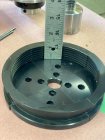Professional woodturner Phil Irons contacted me after the demo that I did for the Woodturners Worldwide Online symposiums. During the demo, I mentioned, as I often did, that I had to take it easy when hollowing the calabash. First, because my lathe is 3HP, and the Milo wood is rather soft. I have had a few bowls come off when rough turning with my 3/4 in Thompson gouge. Phil told me that he is on a crusade, to educate as many turners as possible to use big jaws, make big tenons. Phil makes his tenon so that by turning less than a quarter turn the big jaws are completely closed. A sign of success is when the entire spigot is black, just like when you see only a few areas of the spigot black, where the jaws were making contact. I sort of dismissed his advice. Then I had my small accident. I have now started to use my Vicmarc VM120 with the big jaws for most of my work. I'm not quite there, I have to do about one turn of the key. I can really hog out now while turning, and the bowl does not move at all, with the small jaws, even with the perfect tenon, which I do, no bragging, just a statement, the bowl can move a bit, and I had to re-sit it in the tenon. I just ordered a Vicmarc VM150. Yesterday I did an IRD to Phil's club in England, he recommended me because he enjoyed my demo for WW. That was a very high compliment for me. Also in attendance were professional turners Andrew Hall and fellow Woodturning Magazine writer Pat Caroll.
On the other side of the spectrum, we have Stuart Batty. he spent a week with me here. Turning every day. His tenons are tiny. Stu's tenon gave me that warning in the stomach, I always moved out of the line of fire, LOL. After my 9 stitches in my arm, I will be making what my gut instinct tells me, big nice perfect tenon for the large jaws on the 120, and soon on the 150.
I used to ask during demos, who said the tenon has to be 1/3 of the size of the bowl? Now I can say, I do, or even bigger!
On the other side of the spectrum, we have Stuart Batty. he spent a week with me here. Turning every day. His tenons are tiny. Stu's tenon gave me that warning in the stomach, I always moved out of the line of fire, LOL. After my 9 stitches in my arm, I will be making what my gut instinct tells me, big nice perfect tenon for the large jaws on the 120, and soon on the 150.
I used to ask during demos, who said the tenon has to be 1/3 of the size of the bowl? Now I can say, I do, or even bigger!

